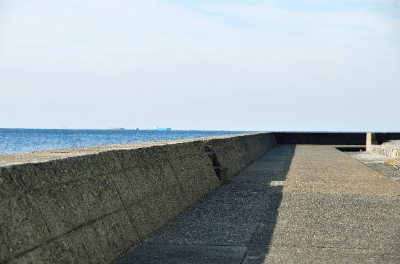What Is a Breakwater?

A breakwater, also known as such in English, is a structure that forms the main part of the outer facilities in harbors.
It is installed to reduce the intrusion of waves and high tides from the sea into the harbor. Harbors where ships anchor are ideally located in calm waters. In the past, harbors were established in places with fewer waves due to geographical and natural conditions, such as inlets, inland seas, or coastlines surrounded by islands.
As maritime trade expanded and vessels grew larger, harbors began to be established without being constrained by geographical and natural conditions. This led to the construction of breakwaters by stacking stones at sea to mitigate waves and high tides. Levees are structures built to prevent waves from entering the land and play a role in preventing wave intrusion. The term “breakwater” is specifically used for structures built along the coastline.
Uses of Breakwater
Breakwaters have a long, slender shape like levees and are constructed from the land towards the sea to protect harbors. Breakwaters keep the interior of the harbor calm from waves, protect the land from high tides and tsunamis, and prevent coastal erosion.
Principle of Breakwater
Due to the immense force of ocean waves, without breakwaters, all the energy of the waves strikes the shore. The arrangement of breakwaters weakens the energy of waves hitting the shore, preventing water-related disasters.
There have been numerous historical cases of breakwaters being destroyed by waves. However, since the development of modern breakwater technology, the likelihood of breakwaters being destroyed by waves has decreased.
However, even in highly stable caisson-type breakwaters, there are reported cases of caissons moving or collapsing due to wave forces.
Structure of Breakwater
Breakwaters come in various structures, including sloping breakwaters, vertical breakwaters, composite breakwaters, and rubble-mound breakwaters. There are also structures such as wave-dissipating caisson breakwaters, upper slope caisson breakwaters, semicircular caisson breakwaters, and double-slit type caisson breakwaters.
Furthermore, research is underway on structures like upright emergent tsunami breakwaters, twin-hull breakwaters, and semicircular breakwaters. An upright emergent tsunami breakwater is a breakwater that is usually submerged underwater and emerges during emergencies. Although twin-hull breakwaters theoretically reduce tsunami height to one-tenth, it is currently a theoretical value. Semicircular breakwaters are also known as semicircular caisson breakwaters.
Types of Breakwaters
1. Sloping Breakwater
Sloping breakwaters are constructed by stacking large stones or concrete blocks. This is the traditional shape of a breakwater and is historically the oldest type. In modern times, it is used in areas where many stones are available, and wave conditions are not too strong, such as shallow ports.
Types using loose stones are called rubble slope breakwaters, and those using concrete blocks are called block slope breakwaters.
2. Vertical Breakwater
Vertical breakwaters are constructed almost vertically from the seabed to the sea surface using concrete blocks or underwater structures called caissons. A solid seabed is required, limiting installation locations.
Types using concrete blocks are called concrete block vertical breakwaters, and those using caissons are called caisson vertical breakwaters.
3. Composite Breakwater
Composite breakwaters combine a sloping breakwater foundation with an upright breakwater on top. They are known for high stability and are the most commonly used breakwater type in Japan. The functions of the sloping and vertical parts can be adjusted according to the size of the foundation and the vertical breakwater, providing flexibility against waves.
Types with vertical breakwater parts are also called caisson composite breakwaters or concrete block composite breakwaters.
4. Rubble-Mound Breakwater
Rubble-mound breakwaters place tetrapods on the front face of the breakwater regardless of the breakwater’s structure. This significantly reduces the force of the waves.
5. Wave-Dissipating Caisson Breakwater
Caissons have holes for waves to pass through, weakening wave energy and subduing wave forces on the breakwater.
6. Upper Slope Caisson Breakwater
The upper part of the caisson is inclined, suppressing wave energy.
7. Semicircular Caisson Breakwater
Mitigates the generation of reflected waves due to the breakwater’s reflection on the shore.
8. Double-Slit Type Caisson Breakwater
The circular caisson has two internal voids, resulting in a high wave-dissipating function.